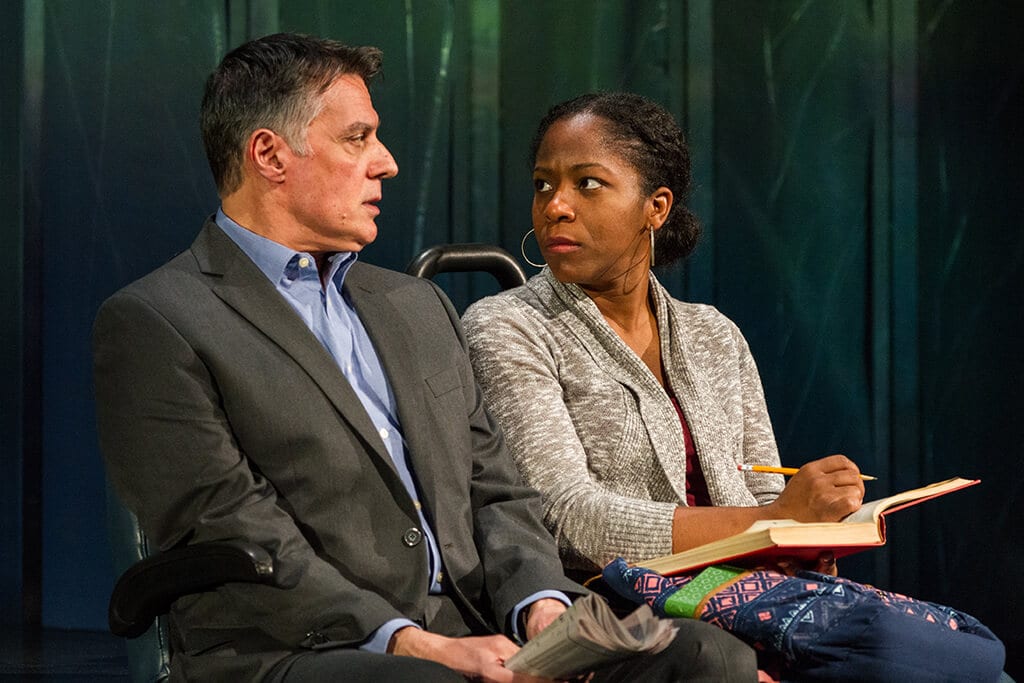Renowned playwright Graham’s “White Guy” perceptively explores racism, inequality, violence, bereavement, and alienation among a wide range of complex social issues and human emotions. The production begins as Ray, played proficiently by Robert Cuccioli, stands indomitably in the center of the dark stage, while hundreds of colorful stock symbols and prices flash over him and across the set. Impeccably dressed, Ray is an affluent financial officer for an investment firm, a self-described “numbers guy.” We hear the noises of a bus. House right, a young woman, Shatique (Danielle Lenee), dressed in nurse’s scrubs and holding several textbooks on her lap, is staring impassively out the window. Presumably, she’s had a long, exhausting day. The disparity between the two characters is unmistakable.
The stage lights rise. Ray and his attractive, stylishly dressed wife, Roz (Susan McKey), are engaged in conversation. Ray’s clearly depressed. His long, lucrative career in the world of high finance no longer seems satisfying. He suggests the couple sell everything they own, including their large, suburban home, and just take off. Although Roz, who teaches in one of Philadelphia’s highly segregated, inner city public high schools, indulges her husband, she has no intention of leaving her job, which brings her considerable fulfillment. One gets a sense they’ve had this conversation before. While this dialogue about alienation, estrangement, disaffection, and the lack of meaning so many experience in modern life, the play promptly pivots to its central theme: the problems of race in America.
Initially, race is introduced as an intellectual and theoretical issue. Roz and Ray’s surrogate son, Christopher (Jonathan Silver) and his girlfriend, Molly (Jessica Bedford), join the couple for drinks on their expansive patio, and the conversation turns quickly to race. The interlocutors are very well-educated, but the exchange abruptly becomes accusatory—“See, you are a racist,” Roz informs Molly, a self-avowed liberal. Christopher is eager to discuss the findings of his PhD dissertation, a study entitled, “Male African-American Images in Television Advertising.” Black males, he asserts, are frequently seen in positions of considerably higher social statuses on TV than they occupy in real life. “It’s pandering,” Roz points out. “How many corporations have a black guy at the head of the table? Not nearly as many as they show on TV.” Christopher’s research evokes the groundbreaking work of media scholar, George Gerbner, whose research showed that African-Americans, at least in the entertainment media, are shown as healthier, wealthier, and more successful than characters of other races and ethnicities. As a result, white people, ostensibly the most segregated group in America, develop an inaccurate perception of the black experience, believing the media fiction. Consequently, they place blame squarely on the shoulders of African-Americans who don’t take advantage of the wondrous opportunities now open to all.
In Act II, the philosophic discussion of race relations moves from the proverbial couch to the mean streets of Philadelphia. We learn of the devastating heartbreak Ray is enduring and the disturbing reason he spends so much time on the city bus engaged in conversation with Shatique. Apparently, under these challenging circumstances, Ray’s purported racial benevolence is about to become undone, disrupting the lives of those seen and unseen.
“White Guy on the Bus” offers a thought-provoking examination of current race relations in America. Graham’s writing is imaginative and compelling, and the plot adeptly blends a coherent structure with intrigue and surprise. Cast members convincingly interpret the complicated vicissitudes their roles demand, and the performance flows effortlessly. A triumph at most every level.



